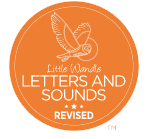PHONICS
At West Hampstead Primary School we teach phonics using the Little Wandle Letters and Sounds Revised synthetic phonics scheme. Phonics is taught to all children in Reception and Year 1 however phonics intervention will occur for any child who will benefit from additional support in their reading. Moreover, children in Nursery play initial sound and oral blending games so that they are exposed to letter sounds before they begin Reception.

Phonics is taught daily and to the whole class. This ensures that every child is exposed to all sounds being taught, giving them the best possible chance to progress as quickly as possible.
Phonics lessons are broken up into three parts:
- Revisit and review
- We go through previously learnt sounds and words
- Teach and practise
- New content is taught
- Practise and apply
- Children use new sounds to read and write words and sentences
During phonics lessons, the children are exposed to new vocabulary linked to our phonics lessons. Below is a description of the terminology used so that you can support your child at home.
Phoneme – a unit of sound represented by a letter symbol
Grapheme – a letter or group of letters that represent a sound
Digraph – two letters that make one sound
Trigraph – three letters that make one sound
Tricky word – a common exception word that generally does not follow ordinary phonemic sounds
Soundtalk – breaking a word into individual sounds before blending them together
Blend – fluently joining sounds together to read a word
Guided Reading
From Reception, children are taught to read using phonically decodable books that match their phonic knowledge. This will be with an adult in a small group (around 6 children) three times a week. Each reading practice session has a clear focus, so that the demands of the session do not overload the children’s working memory. The reading practice sessions focus on three key reading skills:
- Decoding - the process of translating a combination of letter sounds into reading words.
- Prosody - speaking with expression and making meaning of language and punctuation in writing.
- Comprehension - the understanding and interpretation of what has been read.
In Reception these sessions start as soon as children are able to blend and can begin from Week 4. Children who are not yet decoding have daily additional blending practice in small groups, so that they quickly learn to blend and can begin to read books. These sessions continue throughout Year 1.
Home learning
Each week, children in Reception and Year 1 will be sent home with Words of the Week homework. This aims to consolidate the phonics content they have learnt that week. Additionally, we encourage you to spend 10 minutes a day reading with your child. Research has shown that this will increase a child’s word exposure by around 700,000 words per year (https://www.scilearn.com/wp-content/uploads/add-ten-minutes-of-reading.pdf).
Here you can find information and resources from the Little Wandle Letters and Sounds scheme that we use to teach phonics in Reception & Year 1.
The attachments include:
- downloadable 'Words of the Week' documents that correspond with your child's year group, term and week of learning. Paper copies of these are also sent home weekly. We encourage you to use these in addition to your child's reading books to consolidate the phonics that they are learning in school. See tabs on the right of page.
- guidance for Reception parents on reading wordless books with your child at home
- any further communication regarding phonics (e.g Handout from parent coffee morning).
In addition to the resources below, you can find useful information on the Little Wandle For Parents website including videos of the taught phonemes, an overview of the sounds covered and further guidance on how phonics is taught in school.

